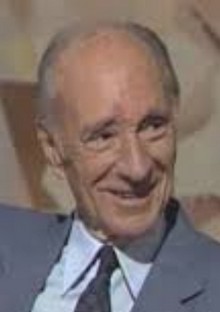Justino de Azcárate facts for kids
Quick facts for kids
Justino de Azcárate y Flórez
|
|
|---|---|

Azcárate c. 1983
|
|
| Deputy for Leon | |
| In office 1931–1936 |
|
| Minister of State | |
| In office 19 July 1936 – 19 July 1936 |
|
| Preceded by | Augusto Barcía Trelles |
| Succeeded by | Augusto Barcía Trelles |
| Royal Senator | |
| In office 21 July 1977 – 2 January 1979 |
|
| Senator for Leon | |
| In office 1 March 1979 – 31 August 1982 |
|
| Personal details | |
| Born | 23 August 1903 León, Spain |
| Died | 17 May 1989 (aged 85) Caracas, Venezuela |
| Occupation | Lawyer, politician |
Justino de Azcárate y Flórez (born August 23, 1903 – died May 17, 1989) was an important Spanish lawyer and politician. He came from a rich family that had a long history of being involved in politics. Justino had ideas that supported a republic, which means a country led by elected officials, not a king.
He was a representative (called a deputy) in the Second Spanish Republic. After the Spanish Civil War, he had to live away from Spain in Venezuela for 38 years. When Spain became a democracy again, he returned and became a Senator. He played a big part in helping Spain peacefully change back to a democratic government.
Contents
Early Life and Family
Justino de Azcárate y Flórez was born in León, Spain, on August 23, 1903. His family was well-known for being smart and having liberal ideas. They were originally from a region called Basque Country, but an ancestor moved to León in 1690.
Justino's grandfather, Patricio de Azcárate, was a governor and translated many famous books by thinkers like Plato and Aristotle. His uncle, Gumersindo de Azcárate, was a respected scholar and lawyer. He was also a Republican deputy for León for 30 years. Justino's older brother, Pablo de Azcárate, also became a deputy and later an ambassador to the United Kingdom.
Justino grew up in a comfortable home. He learned English and went to a German school. Later, he studied Law in Madrid. After finishing his studies, he helped a university professor. He became involved in a movement to end the rule of a dictator named Miguel Primo de Rivera. He worked with a group of thinkers called Al Servicio de la República (meaning "At the Service of the Republic").
Role in the Second Spanish Republic
When the Second Spanish Republic began in 1931, Justino de Azcárate was elected as a Deputy for León. He was only 29 years old. He became an Undersecretary of Justice, helping the Minister of Justice.
His political group did not join the Popular Front because it included Communists.
When the Spanish Civil War started on July 18, 1936, Azcárate was named Minister of State. However, he could not take the job because he was near León, a city that quickly fell to the rebel forces. He went into hiding but was arrested a few days later. He was held in prison in Valladolid. In October 1937, he was released as part of a prisoner exchange. After his release, he worked from France to try and bring the two sides of the war closer together. He helped arrange prisoner exchanges and pardons.
Life in Exile
After the Spanish Civil War ended, Justino de Azcárate lived in Venezuela for almost 40 years. He started a family there and had many grandchildren and great-grandchildren.
In Venezuela, he became an important economic adviser to the government. He also directed the Mendoza Foundation, which was set up to help people and support good causes. He worked closely with the founder, Eugenio Mendoza, for many years.
In the 1960s, he started traveling back to Spain. He encouraged rich people and companies in Spain to give money to art and culture, a practice called philanthropy. He connected Spanish groups with important philanthropists in Latin America and the USA. In 1973, he helped prepare a report about how Spanish art was protected during the Civil War.
Return to Spain and Democracy
On June 15, 1977, Justino de Azcárate received a phone call from King Juan Carlos I of Spain. The King asked him to become a senador real (Royal Senator). When he returned to Spain, newspapers saw it as a sign that things were getting back to normal.
He served as a senator from July 21, 1977, to January 2, 1979. Even though he believed in a republic, he understood that the King would be important in helping people from both sides of the Civil War come together.
Azcárate helped pass a measure that called for the return of the remains of King Alfonso XIII and the first president of the republic, Manuel Azaña. He also helped bring Pablo Picasso's famous painting Guernica back to Spain from New York City.
After his time as Royal Senator, he joined a political party called the Union of the Democratic Centre. He was elected as a senator for León again on March 1, 1979, and served until August 31, 1982.
After returning to Spain, Azcárate became president of the Hispania Nostra Association, which works to protect Spain's heritage. He also led the Francisco Giner de los Ríos Foundation. In September 1982, he was elected president of the board of the Museo del Prado, a famous art museum.
Justino de Azcárate y Flórez passed away on May 17, 1989, in Caracas, Venezuela, at the age of 85. His nephew, Manuel Azcárate, was also a well-known journalist and politician.
Sources
- "Manuel Azcárate muere en Madrid a los 81 años" (in Spanish). El País (Madrid). 1998-08-25. http://elpais.com/diario/1998/08/25/espana/903996011_850215.html. Retrieved 2015-11-29.
Images for kids
See also
 In Spanish: Justino de Azcárate para niños
In Spanish: Justino de Azcárate para niños


